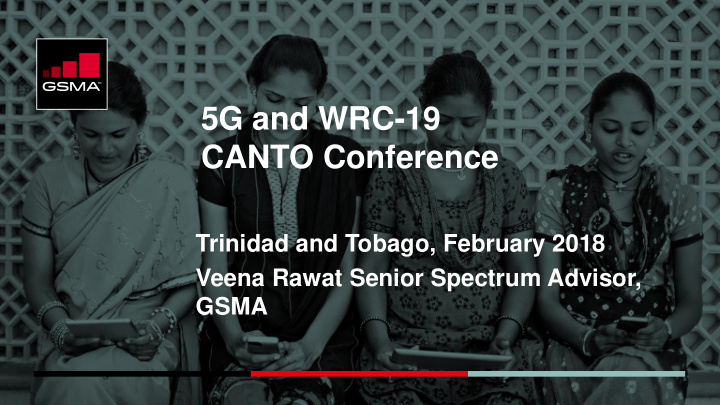



5G and WRC-19 CANTO Conference Trinidad and Tobago, February 2018 Veena Rawat Senior Spectrum Advisor, GSMA
5G USE CASES AND POSSIBILITIES FOR AFRICA 5G ENABLES DIGITAL TRANSFORMATION ACROSS GOVERNMENT AND MULTIPLE INDUSTRIES: eMBB Enhanced Mobile Broadband 3D video, Gigabytes in UHD screens a second Work & play in the cloud Smart Augmented Home / reality Building Industry automation Mission critical application Voice Smart Self Driving City Future IMT Car URLLC mMTC Ultra-reliable and Massive Machine Type Low Latency Communications Communications
GSMA’s positions on 5G spectrum 1. Significant new widely harmonised mobile spectrum is needed to ensure 5G services meet future expectations and deliver on the full range of potential capabilities 2. 5G needs spectrum within three key frequency ranges to deliver widespread coverage and support all use cases. The three ranges are: Sub-1 GHz, 1-6 GHz and above 6 GHz 3. WRC-19 will be vital to realise the ultra-high-speed vision for 5G and low cost devices 4. Licensed spectrum should be the core 5G spectrum management model. Unlicensed spectrum can play a complementary role 3
The GSMA’s key positions on AI 1.13 1. A successful identification of spectrum for IMT under Agenda Item 1.13 is vital to realise the full potential of mobile 5G networks 2. At this point in the WRC-19 cycle, the GSMA supports focusing studies on the 26 GHz, 32 GHz and 40 GHz bands. The 26 GHz band has the highest priority 3. Bands above 24 GHz offer a good opportunity for the coexistence of 5G and other wireless services 4. Bands above 45 GHz also need further consideration 5
5G and WRC-19 • • 26 GHz ( 24.25-27.5GHz) – high priority Widely harmonised spectrum band • Three key frequency ranges: • 40(37-43.5GHz)) GHz offers potential • Sub-1 GHz tuning range: • 1-6 GHz • 42 GHz - Europe’s as priority band • Above 6 GHz • 38 GHz - supported in other • Coexistence with other services in regions higher frequency bands • 32 GHz ( 31.8-33.4GHz) - potential due • Technology neutral spectrum licenses to low current usage Bands above 45 GHz under consideration 6
Improve harmonization of some bands from WRC-15 for IMT • Review FN’s for the band 470 (614) - 698 MHz; 3300-3400 MHz; 3600-3700 MHz and 4800-4900 MHz with the view to improve harmonization (Refer to Annex) • Process: Interested Administrations submit requests to WRC-19 subject to no objection from affected neighbour countries
The 600 MHz (614-698 MHz) band plan and WRC-15 Decisions Downlink Uplink 698 MHz 617 MHz 663 MHz 652 MHz - WRC-15 decision (RR5.308A): IMT in the band 614-698 MHz for Bahamas; Belize; Barbados; Canada; Colombia; Mexico; US - R2 Countries with existing allocation to mobile ( RR5.293): Chile; Cuba; Guyana; Jamaica; Panama, no IMT identification -RR5.308 : new allocation to mobile service for Belize and Colombia at WRC-15 - Citel approved Band plan in Dec, 2017 8
Citel Band plan for C band MHz 3300 3400 3600 3700 5.429D 5.431B (Region 2) 5.434 1 TDD 2 TDD 3 TDD 9
Region 2 Countries with IMT identification in 3.3- 3.4 GHz and 3.6-3.7 GHz band 5.429D : Argentina, Colombia, Costa Rica, Ecuador, Mexico and Uruguay, the use of the frequency band 3 300-3 400 MHz 5.534 : In Canada, Colombia, Costa Rica and the United States, the frequency band 3 600-3 700 MHz 10
Summary 1. Harmonised high-frequency mobile spectrum is needed to ensure 5G services meet future expectations 2. WRC-19 decisions for AI 1.13 will be vital to realise the ultra-high-speed vision for 5G and low-cost devices 3. Support from the Caribbean states for the identification of priority bands for 5G though Citel process will be key to achieve 5G vision. 11
GSMA Reference documents 12
5G spectrum – read more about it http://www.gsma.com/spectrum/ 5g-spectrum-policy-position/ 13
Recommend
More recommend